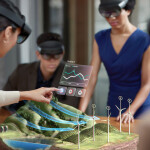Introduction
Augmented reality is revolutionizing the way we perceive and interact with digital content. It bridges the gap between the virtual and physical worlds, offering a rich and immersive user experience. Whether it's overlaying digital characters in a gaming environment or providing real-time information about the surroundings, AR has the potential to transform numerous industries.
Understanding Augmented Reality
Augmented reality refers to the technology that combines virtual elements with the real world, creating an enhanced perception of reality. Unlike virtual reality (VR), which immerses users in a fully simulated environment, AR overlays digital information onto the physical world. This allows users to interact with both the virtual and real elements simultaneously.
History of Augmented Reality
The concept of augmented reality dates back to the 1960s when Ivan Sutherland developed the first head-mounted display system called "The Sword of Damocles." Since then, significant advancements in computing power and mobile devices have paved the way for widespread adoption of AR technology.
How Does Augmented Reality Work?
Augmented reality works by utilizing computer vision, tracking, and display technologies. The process involves capturing real-world data, analyzing it, and then overlaying digital content onto the user's view. Various devices, such as smartphones, tablets, and AR headsets, serve as the interface between the user and the augmented reality experience.
Types of Augmented Reality
There are different types of augmented reality experiences, categorized based on the level of immersion and interaction. These include marker-based AR, markerless AR, projection-based AR, and superimposition-based AR. Each type offers unique features and is suitable for different applications.
Applications of Augmented Reality
The applications of augmented reality are diverse and continue to expand rapidly. In entertainment and gaming, AR has revolutionized the way we play and interact with digital content. It has introduced immersive experiences like Pokemon Go, where virtual creatures are superimposed onto the real world using a smartphone's camera.
In education, AR is transforming traditional learning methods by providing interactive and engaging experiences. Students can visualize complex concepts through 3D models or explore historical sites virtually. Healthcare professionals are leveraging AR for surgical planning, medical training, and enhancing patient outcomes.
Augmented Reality in Entertainment and Gaming
AR has taken the entertainment and gaming industry by storm. It offers unique and interactive experiences that blur the line between the digital and physical realms. Games like Minecraft Earth and Harry Potter: Wizards Unite enable players to explore virtual worlds overlaid on their real surroundings, fostering a sense of adventure and excitement.
Augmented Reality in Education
AR has the potential to revolutionize education by making learning more interactive and immersive. Students can engage with educational content through augmented reality applications, visualizing complex concepts in a three-dimensional space. This hands-on approach enhances comprehension and retention, making education more engaging and enjoyable.
Augmented Reality in Healthcare
In healthcare, AR is transforming various aspects of patient care. Surgeons can utilize AR to superimpose medical images and data onto a patient's body during surgery, improving precision and reducing risks. AR also enables medical professionals to simulate procedures, train in virtual environments, and enhance diagnostics and treatment planning.
Augmented Reality in Manufacturing and Design
AR is revolutionizing the manufacturing and design processes by providing real-time visualization and collaboration tools. Engineers and designers can overlay digital models onto physical prototypes, allowing for better analysis and identification of design flaws. AR also facilitates remote collaboration, enabling teams to work together on projects regardless of their geographical locations.
Challenges and Limitations of Augmented Reality
While augmented reality has immense potential, it also faces several challenges and limitations. These include technological limitations, such as the need for advanced hardware and software infrastructure, as well as concerns regarding privacy, security, and user acceptance. Overcoming these challenges will be crucial for the widespread adoption of AR.
Future Trends in Augmented Reality
As technology continues to evolve, the future of augmented reality looks promising. Advancements in hardware, such as lightweight and high-resolution displays, will make AR more accessible and immersive. The integration of artificial intelligence and machine learning will further enhance the capabilities of AR applications, providing personalized and context-aware experiences.
Conclusion
Augmented reality is a transformative technology that is bridging the gap between the digital and physical worlds. Its applications span across various industries, from entertainment and gaming to education, healthcare, and manufacturing. As the technology continues to advance, augmented reality holds the potential to revolutionize how we interact with digital content and the world around us.
Frequently Asked Questions
Q1: Is augmented reality only limited to gaming and entertainment? Augmented reality has applications beyond gaming and entertainment. It is being utilized in education, healthcare, manufacturing, design, and many other industries.
Q2: What devices are required for experiencing augmented reality? Devices such as smartphones, tablets, and AR headsets can provide augmented reality experiences. However, the level of immersion and interaction may vary depending on the device.
Q3: Are there any privacy concerns associated with augmented reality? Privacy concerns exist in augmented reality, especially regarding the collection and usage of user data. It is important for developers and stakeholders to prioritize user privacy and security.
Q4: Can augmented reality enhance learning experiences? Yes, augmented reality has the potential to enhance learning experiences. It provides interactive and immersive content that can make education more engaging and effective.
Q5: What are the future trends in augmented reality? The future of augmented reality holds exciting possibilities. Advancements in hardware, artificial intelligence, and machine learning will further enhance the capabilities and accessibility of AR.








